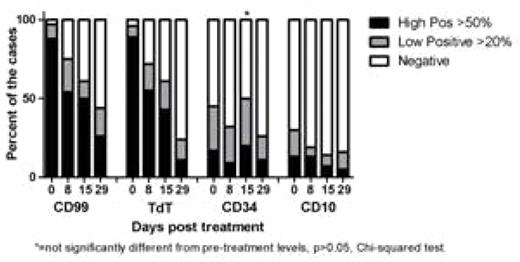Abstract
Immunophenotyping has become a primary modality in detection of minimal residual disease (MRD) in acute leukemia. Detection and enumeration of leukemic blasts relies on the recognition of the aberrancies in the immunophenotype of the abnormal population. Antigens associated with immature phenotype are thought to represent particularly good markers for identification of leukemic cells. In particular the expression of terminal deoxynucleotide transferase (TdT) on the T-lineage blasts outside the thymus and aberrantly high expression CD99 have been shown to be present in virtually all cases of T-ALL at diagnosis. CD34 and CD10 have also been used as markers of immaturity and aberrancy in MRD. Upon therapy precursor B cell ALL blasts have been shown to lose markers associated with immaturity complicating the detection of MRD. Immunophenotypic changes in T-ALL have not been well characterized. We studied the utility of these markers in the detection of MRD in pediatric patients undergoing chemotherapy under the Children’s Oncology Group (COG) research protocol for treatment of T-ALL. Per protocol (COG-AALL0434) patients received cytarabine intrathecally (IT) on day 1; vincristine IV and daunorubicin hydrochloride IV on days 1, 8, 15, and 22; prednisone IV or orally twice daily on days 1–28; pegaspargase intramuscularly (IM) on day 4, 5, or 6; and methotrexate (MTX) IT on days 8 and 29. Blood and bone marrow samples from 74 consecutive patients enrolled in the protocol between 05/2007 and 04/2008 and who had at least one positive sample (>0.1% blasts of total white cells) at days 8, 15 or 29 post first day of induction were analyzed at diagnosis and in the setting of MRD detection for abnormal expression of TdT, CD99, CD34 and CD10 by multiparameter flow cytometry. Expression of individual antigens was assessed both by percentage of the leukemic blasts with levels of expression above those of normal mature T cells in the samples and by mean fluorescence quotient relative to normal T cells. Consistent with prior reports, nearly all patient samples demonstrated expression of TdT (96%, MFQ=1.35(central 95%=1.01–1.74)) and high expression of CD99 (96%, MFQ=1.34(1.01–1.59)) on at least 20% of abnormal cells at diagnosis. Moreover, TdT and CD99 could be used for blast enumeration with 88% of cases showing greater than 50% positivity for each marker. Expression of these markers began to decline by day 8 and continued to decrease through day 29. Thus only a minority of positive cases showed expression of TdT (24%, MFQ=1.08(0.9–1.62), p<0.001, by Wilcoxon signed-rank test) or CD99 (44%, MFQ=1.14 (0.88–1.51) p<0.001) and in yet smaller proportion of cases could these markers be used for blast enumeration (11% and 26% respectively) by day 29. Median decline for CD99 positivity on the abnormal blasts was 24%, 26% and 62% at day 8, 15 and 29 respectively. Similarly, the differences for TdT were 30%, 44% and 60% respectively. CD34 and CD10 were expressed on a minority of pre-treatment cases (41% and 28% respectively) and expressed similar but less dramatic decline. At day 29, 25.9% of cases expressed CD34 and 16.2% of cases expressed CD10. Median change was 16% for CD34 and 17% for CD10 for cases that expressed those antigens before treatment. Figure 1 demonstrates the declines in both “high positive” with abnormal blasts showing greater than 50% positivity for a marker and of “low positive” cases showing between 20–50% positivity. We conclude that expression of common T-ALL markers of immaturity dramatically declines in the setting of chemotherapy, reducing their value for immunophenotypic detection of MRD. We speculate that this change is due to either chemotherapy induced partial maturation or selective survival of more mature aberrant cells. These results suggest the need for expansion of immunophenotyping panels to decrease reliance on individual markers of immaturity for T-ALL detection in order to achieve a more accurate evaluation of MRD.
Disclosures: No relevant conflicts of interest to declare.
Author notes
Corresponding author


